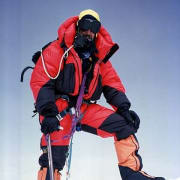Climbing Expeditions in the Himalayas Pursue the End of Season

Concluding the Fall Himalayan Climbing Season
The second, or fall, climbing season in the Himalaya will soon end. Deep winter will soon envelope the highest mountains in the world rendering these giants unclimbable. Several expeditions have set off on their final climbs of the year in Nepal and Tibet. Elite mountain guiding company Madison Mountaineering, led by Garrett Madison, recently embarked to three appealing peaks in Nepalese region: Ama Dablam, Island Peak and Lobuche East. Madsion Mountaineering just reported that their three expedition teams have launched. (Related Article on the end of the 2024 spring Himalayan climbing season)
“Today our team in Nepal received blessings at the historic Buddhist monastery in Pangboche Village. The Pangboche monastery is the oldest monastery, or Gompa, in the Khumbu region. Tomorrow our Ama Dablam climbers will arrive at their base camp, and our trekkers bound for Everest Base Camp, Lobuche East and Island Peak will enjoy a scenic day in the village of Pheriche.” – Madison Mountaineering
Ama Dablam
Ama Dablam, often referred to as the "Matterhorn of the Himalayas," is one of the most iconic and visually striking peaks in the world of mountaineering. Located in the Khumbu region of eastern Nepal, Ama Dablam stands 22,349 ft. Its name, Ama Dablam, translates to "Mother's Necklace" in Sherpa language, with "Ama" meaning mother and "Dablam" representing a pendant-like formation hanging from the mountain, resembling a traditional Sherpa double-pendant necklace containing pictures of the gods, worn by Sherpa women. The mountain serves as a cultural and spiritual symbol for the Sherpa people, who consider it sacred. Its elegant pyramid-shaped summit, with steep rock faces and ice-covered spires, presents a challenging ascent for experienced high-altitude mountaineers.
The first successful ascent of Ama Dablam was made in 1961 by a team of mountaineers from New Zealand and the United States. The climb requires a combination of technical rock climbing skills and high-altitude mountaineering expertise. Ama Dablam, situated near the Everest Base Camp, offers an excellent training and acclimatization climb for those seeking to later attempt Mt. Everest or Lhotse. The typical ascent and descent on Ama Dablam takes approximately 3 to 4 weeks.
Island Peak
Island Peak, or Imja Tse, located in Sagarmatha National Park in the Everest region of Nepal, stands 20,305 feet. Island Peak offers an ideal introduction to high-altitude mountaineering while providing spectacular views of dramatic Himalayan neighbors, including Lhotse, Nuptse, and Ama Dablam. The climb typically starts from Dingboche, progressing through Chhukung, which leads to high camp at approximately 18,400 feet. The mountain was named Island Peak in 1953 by members of a British Everest expedition, as it resembles an island in a sea of ice when viewed from lower altitudes. The peak extends from a ridge coming down off the south end of Lhotse Star..
The ascent combines trekking and technical climbing, and features steep, glaciated terrain, crevasses, and a final ridge requiring full mountaineering techniques – rope, crampons and ice axes. The climb is achievable for those with intermediate to elite mountaineering skills and proper acclimatization. Island Peak serves as a training ground for those aspiring to tackle higher peaks, such as Ama Dablam, Lhotse and Mt. Everest.
Lobuche East
Like Island Peak, Lobuche East is located in Nepal and lies close to the Khumbu Glacier outside of Lobuche. Climbing Lobuche East, at 20,075 feet, offers a mix of trekking and technical mountaineering much like Island Peak, presenting a great warmup to higher Himalayan peaks. Situated in the Everest region of Nepal, the climb generally begins from Lobuche village, where climbers progress to high camp at approximately 17,000 feet. The ascent demands an adequate level of fitness, acclimatization, and basic mountaineering skills, as it involves moving over glaciers and crevasses requiring crampons, ice axes, and fixed ropes. Also similar to Island Peak, the route presents steep sections and a final push along a sharp ridge. Key highlights of the climb include stunning views of nearby Himalayan giants, including Everest, Lhotse, and Ama Dablam. The first recorded ascent of Lobuche East was made by Laurence Nielson and Sherpa Ang Gyalzen on April 25, 1984.
